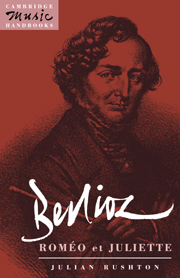Book contents
- Frontmatter
- Contents
- List of abbreviations and acknowledgements
- 1 Introduction
- 2 The genesis of Roméo et Juliette
- 3 Berlioz, Shakespeare, and Garrick
- 4 Exordium: Introduction and Prologue; Roméo seul
- 5 The heart of the matter: Scène d'amour; La reine Mab
- 6 Tragedy and reconciliation: Convoi funèbre; Roméo au tombeau; Finale
- 7 A view from 1839 by Stephen Heller
- 8 Performance and reception: 1839 and beyond
- 9 Afterword: Roméo et Juliette as covert opera
- Appendix 1
- Appendix 2
- Notes
- Select bibliography
- Index
8 - Performance and reception: 1839 and beyond
Published online by Cambridge University Press: 18 November 2009
- Frontmatter
- Contents
- List of abbreviations and acknowledgements
- 1 Introduction
- 2 The genesis of Roméo et Juliette
- 3 Berlioz, Shakespeare, and Garrick
- 4 Exordium: Introduction and Prologue; Roméo seul
- 5 The heart of the matter: Scène d'amour; La reine Mab
- 6 Tragedy and reconciliation: Convoi funèbre; Roméo au tombeau; Finale
- 7 A view from 1839 by Stephen Heller
- 8 Performance and reception: 1839 and beyond
- 9 Afterword: Roméo et Juliette as covert opera
- Appendix 1
- Appendix 2
- Notes
- Select bibliography
- Index
Summary
Following its first three performances, Roméo et Juliette suffered an immediate erosion of integrity. There were only six more complete performances in Berlioz's lifetime, none of them in France; meanwhile he split off various sections, himself inaugurating the practice (which continues today) of performing the three main instrumental movements as a triptych. By far the commonest extract in Berlioz's concerts, however, was No. 2 by itself; only very recently has No. 6, although purely orchestral, been added to conductors' selections. Excerpts were standard fare in Berlioz's concerts in Paris and abroad, and he was frequently able to claim a major success from these performances in his travel memoirs (intended for publication) and in personal letters.
Integrity is a quality even some friendly critics suggest that Roméo et Juliette always lacked. But its dismemberment did not result from any perception on Berlioz's part that it was a miscellany like Lélio or Tristia: by performing separate movements, he was treating Roméo et Juliette no differently from his other symphonic works. As a promoter, he had to appeal to his audience while avoiding excessive outlay; performance of the instrumental movements was an obvious way of reminding the public of the work's existence without the cost of soloists and chorus. As early as August 1840, therefore, while introducing the new Symphonie funèbre to audiences, he performed the Fête chez Capulet, and in December he mounted the first four movements in a concert at the Conservatoire. Nos. 5 and 6 having been relatively unsuccessful, and No. 7 being expensive (with additional chorus), they were conveniently omitted in favour of the Symphonie fantastique. ‘Strophes’ from the Prologue appeared separately in print as early as 1839.
- Type
- Chapter
- Information
- Berlioz: Roméo et Juliette , pp. 70 - 79Publisher: Cambridge University PressPrint publication year: 1994
- 1
- Cited by



